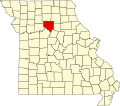2010 census
As of the census [17] of 2010, there were 17 people, 9 households, and 6 families living in the village. The population density was 94.4 inhabitants per square mile (36.4/km2). There were 18 housing units at an average density of 100.0 per square mile (38.6/km2). The racial makeup of the village was 70.6% White and 29.4% African American.
There were 9 households, of which 22.2% had children under the age of 18 living with them, 55.6% were married couples living together, 11.1% had a male householder with no wife present, and 33.3% were non-families. 33.3% of all households were made up of individuals, and 22.2% had someone living alone who was 65 years of age or older. The average household size was 1.89 and the average family size was 2.17.
The median age in the village was 63.2 years. 11.8% of residents were under the age of 18; 0% were between the ages of 18 and 24; 5.9% were from 25 to 44; 47% were from 45 to 64; and 35.3% were 65 years of age or older. The gender makeup of the village was 58.8% male and 41.2% female.
2000 census
As of the census [3] of 2000, there were 27 people, 12 households, and 9 families living in the town. The population density was 152.5 inhabitants per square mile (58.9/km2). There were 24 housing units at an average density of 135.6 per square mile (52.4/km2). The racial makeup of the town was 55.56% White and 44.44% African American. Hispanic or Latino of any race were 11.11% of the population.
There were 12 households, out of which 16.7% had children under the age of 18 living with them, 41.7% were married couples living together, 33.3% had a female householder with no husband present, and 25.0% were non-families. 25.0% of all households were made up of individuals, and 16.7% had someone living alone who was 65 years of age or older. The average household size was 2.25 and the average family size was 2.56.
In the town the population was spread out, with 18.5% under the age of 18, 14.8% from 25 to 44, 33.3% from 45 to 64, and 33.3% who were 65 years of age or older. The median age was 54 years. For every 100 females, there were 58.8 males. For every 100 females age 18 and over, there were 46.7 males.
The median income for a household in the town was $42,500, and the median income for a family was $42,500. Males had a median income of $0 versus $11,250 for females. The per capita income for the town was $19,492. None of the population and none of the families were below the poverty line.

